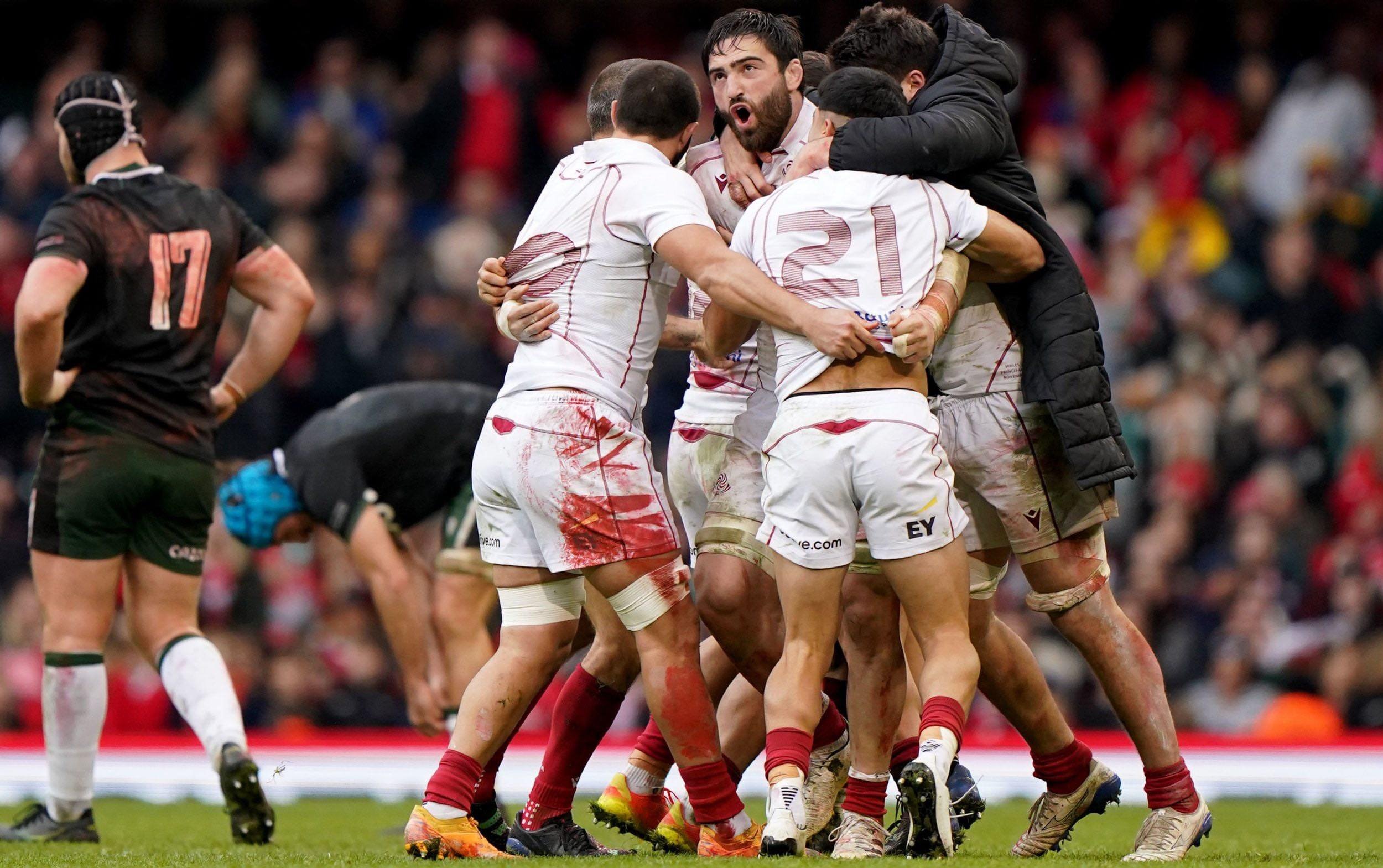The Nations Championship: Is it a good idea?
England raise the Autumn Nations Cup in 2020 - and its spiritual successor looks to be on the way (Credit: Getty)
The latest twist to the ever-changing rugby calendar has now been confirmed.
Following on from the success of the (Covid-enforced) Autumn Nations Cup in 2020, Six Nations Rugby and SANZAAR are now working to formalise a brand-new global international rugby competition. The intended tournament, which has been preliminarily called the ‘Nations Championship’, is slated to begin in 2026.
The tournament will turn the current summer tour and autumn international windows into an array of competitive fixtures featuring the Six Nations and Rugby Championship participants - as well as two further invited nations.
According to reports, the competition will take place every two years, so as not to disrupt the biennial World Cup/Lions tour cycles. The tournament is set to be owned and operated by Six Nations Rugby and SANZAAR, with World Rugby due to sign off on the concept later this year.
A joint statement from the two governing bodies said: “Six Nations Rugby and SANZAAR are working in partnership, alongside global rugby stakeholders, to bring to life a new international rugby competition that will be played in the existing July and November test windows.
“The creation of the new competition has been a collective process from the sport, including World Rugby, unions, key leagues, competitions, and crucially, the International Rugby Players. Set to begin in 2026, the new elite competition will feature all the Six Nations Rugby and SANZAAR teams, with two spaces reserved for invitational unions to join the southern hemisphere group.
“A transparent selection process will be managed by SANZAAR, supported by World Rugby and the International Rugby Players, to determine these two invitational unions.”
The current understanding is that the plan also includes a second division to be created underneath this top tier in order to foster emerging nations, get them regular games and allow for movement between the divisions.
So - is it a good idea? Here, The Flanker breaks down the key arguments for and against the new proposals.
For
More competitive fixtures
The move mirrors the introduction of the Nations League in football and cricket’s World Test Championship - a method of providing impetus and stakes to fixtures that were previously sliding into irrelevance between the events people actually cared about.
Complaints about how many international friendlies were being played in the football world, with very little riding on them, were rife prior to the Nations League. Besides fringe players having opportunities to make their case for competitive selection, there really was not a whole lot that these fixtures offered anyone involved.
Similarly, Test cricket has been given a shot in the arm by giving matches significance beyond themselves or the self-contained series as part of which they take place. The struggle to lend meaning to non-Ashes Test matches or those involving India made it almost a necessity when introduced in 2019.
Fans will simply hope the Nations Championship can have a similar revitalising effect on the international rugby calendar. Windows in July and November, which had previously been reserved for matches with no real significance besides bragging rights, will now host more varied fixtures which carry more weight.
Simply, the proposals potentially offer some clout to the international game that has diminished in recent years.
Opportunities for emerging nations
Looking purely at the top tier, a key part of the proposals has been the inclusion of two free spots for nations outside the Six Nations and the Rugby Championship. This would codify an improvement in the opportunities afforded to smaller and emerging rugby nations to eat at the top table.
While there are problems with the way this proposal has been outlined (more to come on this later), it cannot be denied that it is a significant positive for nations previously only afforded limited or even just occasional opportunities to play the best teams.
They could now compete on the biggest stages and given these chances on a more regular basis.
Georgia have been sticking their hands up for greater international recognition for a number of years (Credit: Joe Giddens/PA)
Exposure is the cornerstone of allowing these sides to improve their fortunes. Playing against better players makes players better.
What is more, the successes these smaller nations achieve under the Nations Championship banner will be amplified by the competitive nature of the fixtures. If Japan, say, were to knock over New Zealand for the first time as part of this new tournament, nobody could level at them that it was not done in a competitive arena.
The value of such a victory rises, and the whole narrative takes a turn.
Opportunities for emerging players?
Along similar lines, it is not just teams that will have the opportunity to benefit from such a reshuffle of the calendar. We contend there are also visible benefits for players looking to crack into international rugby.
Players in what we might call the ‘Top Ten Nations’ traditionally face difficulties in forcing their way into international setups during the competitive rugby that currently exists on the calendar. The Six Nations, the Rugby Championship and the World Cup are hardly seen as good breeding grounds for new talent when the point is about winning.
However, making more competitive international rugby available may increase the chances of some of these players gaining valuable Test experience in a competitive environment.
A part of the joint statement from Six Nations and SANZAAR says: “Involved at every stage of developing the new competition, has been the International Rugby Players. This connection has been key in supporting the wider conversations around the club and international calendar taking place in parallel, and ensuring player welfare has remained a fundamental priority in all decision-making.”
If we take this as true to the process that has been followed so far, player welfare adherence will naturally open more rotation opportunities even amongst the bigger unions - therefore opening up more chances for rising stars of the game.
Commercial opportunities
This is not the side of the game any purist would want to bring to the forefront, but it would be churlish not to point out that it is a vital consideration in modern sport.
In an age where financial matters are coming to a head in rugby around the world - the dissolution of three Premiership clubs is a clear signal of the impact Covid has had on the sport’s finances - the improved prospects for sponsorship and investment that comes with a new competition cannot be ignored.
As well as presumably more prize money being on offer to successful nations within the tournament, teams will also expect greater crowd and TV revenue than would be on offer for non-competitive matches. The benefits of involvement in the competition will be keenly felt from a financial perspective.
This is amplified when one considers the emerging nations that will be involved in the tournament. These nations, who do not get as large a slice of World Rugby’s cheesecake as the more established Test teams, will pick up more money through their involvement and, if successful, find more income opportunities and sponsorship coming their way as a result.
More from The Flanker
Against
No changing of invited nations - at first
A first real fly in the ointment was found with the new proposals in the reported suggestion that there would be no promotion or relegation between the two new competitions until 2030.
The joint statement from the governing bodies said about this two-tier aspect to the proposals: “To strengthen the development pathway for emerging nations, World Rugby will create a second-tier competition that will feature teams from Europe and the rest of the world, with Six Nations Rugby and SANZAAR actively involved in cementing the link between the two divisions.”
We spoke in the pros section of this debate about the possible benefits for the two nations invited to join the top table in its first instance, and what they stand to gain from the concept. The problem is, what happens to the others?
Let’s say, for the sake of argument, that Japan and Fiji are the two sides invited to join the inaugural top tier tournament. Seeing as the two invited sides will join the southern hemisphere section, under the proposals, this seems a fair likelihood.
But look who that now leaves out. Georgia, who have been sticking their hands up ever more firmly for selection in the Six Nations in recent years. The USA, who are hosting the World Cup itself in 2031 and need World Rugby’s support to validate that decision. Samoa. Tonga. Canada. Uruguay.
All sides, in short, who would benefit exponentially from some more exposure to top-level competition, but could well not have it for another seven years at least.
Where does that leave them? Do they just have to sit and risk having their progress checked and stunted while other teams cash in and widen the gulf even further?
A sensible plan for integrating emerging nations into the tournament is key to ensure it serves the game the best, and could be very important in getting viewers across the world on board.
Would we not be better off expanding the existing competitions?
The other problem raised by this currently unknown relationship between the two proposed competitions is that it begs the question of why, if the international competitive game needs expanding, don’t we just make the existing tournaments bigger?
They already have the history and the clout to sustain a mass expansion. No European rugby fan is going to swear off the Six Nations forever just because there is more of it. Same for the Rugby Championship.
It would allow these emerging teams to enter a competition that is already protected and entrenched in terms of its place in the calendar and can be relied upon to provide sustainable involvement at the top end of the game.
With that in mind, here is a counter-proposal for you. The Six Nations is expanded (amount of teams unknown), with fixtures played over both the existing 6N window in February-March and the summer tours window.
Emerging teams like Georgia, Romania, Portugal and Spain could be rotated in and out on a yearly basis as the concept beds down, to give as many as possible a fair crack.
The Rugby Championship is similarly expanded to requisite size and also consumes the summer tours window, as well as its own regular period, altering structure back to the early days of the tournament where each team played each other once. Home advantage could then rotated by year.
The autumn internationals can see the reinstatement of the Autumn Nations Cup, with all major nations involved at the organisers’ discretion.
Possibly here is where the two competition, promotion-relegation structure could be best applied, since these nations are gaining exposure and top-level matches through the expanded regional tournaments.
Hosting rights for the Autumn Nations Cup could be rotated every year between the hemispheres. It’s not perfect, but it shows how the questions about the help the calendar gives the emerging nations could be addressed.
Will these games actually matter?
For all the whatifery about the new concept, this might end up being the stickiest question of them all. For all the good intentions that come with the Nations Championship, will any of it actually matter enough?
The statement announcing the formulation of this new concept was clear in its aim to “sustain and grow the global game” and that the competition will “genuinely excite players and bring new fans to the game”.
That is all very well, but will the fans really be emboldened by it? There is a parallel universe logic in which existing viewers treat it with the same regard they give the current summer and autumn calendar.
Likewise, new or casual fans do not see enough in it to abandon their yearly ritual of Six Nations yah-booing and complete indifference for the rest of the year.
Obviously, there is a long way to go yet in terms of finalising the concept and how it will be presented. The big question simply is, what will this competition do differently that genuinely makes it an event worth paying attention to and being involved in?
If it just ends up being a World Cup Lite, it doesn’t bring a whole lot of purpose and risks devaluing the main event. Similarly, if it is too similar to the existing calendar, it feels like a lot of effort for not much new.
We await with interest to see how this new tournament shapes up, but the trap the governing unions cannot fall into is allowing the tournament to subscribe to the status quo and fade into the backdrop.
Because if they do, it will make no difference whatsoever. If it is about empowering smaller nations, go hard on that. If it is about getting the big guns together more regularly, make it about that.
Just make it something we can get excited about.




















